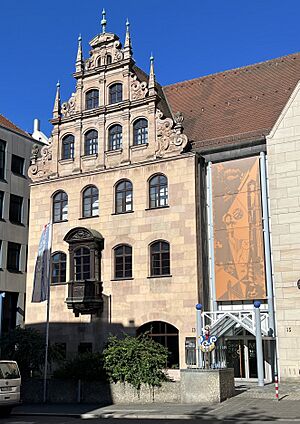Nuremberg Toy Museum facts for kids
The Nuremberg Toy Museum is a famous place in Nuremberg, Bavaria. It's also called the Lydia Bayer Museum. This museum opened in 1971. It shows the amazing history of toys, from ancient times to today. It's known as one of the best toy museums in the world.
Contents
History of the Toy Museum
The Hallersches Haus Building
The museum is located in a very old building at Karlstraße 13–15. This building, called the Hallersches Haus, dates back to 1517. It once belonged to a rich family named Haller. Later, in 1611, a jeweler bought it and made changes to its front.
A special part of the building is its Dockengalerie. This is a wooden walkway built around an inner courtyard. It connects different parts of the building. The word 'Docken' refers to wooden posts used in construction.
The building was badly damaged during World War II. But it was carefully rebuilt in the years that followed. Today, it's an important stop on the "Historical Mile Nuremberg" tour.
Lydia and Paul Bayer's Collection
The heart of the museum's collection comes from Lydia (1897–1961) and Paul Bayer (1896–1982). They spent many years collecting about 12,000 toys. They started collecting in the early 1920s. Back then, most people didn't think toys were important for history or culture.
The Bayers even had their own private museum. It was called the Lydia Bayer Museum and was located in Würzburg.
How the Museum Started
The city of Nuremberg bought the Bayers' large toy collection in 1966. With help from a special group, the Hallersches Haus was ready. The Nuremberg Toy Museum officially opened its doors in 1971.
The museum quickly became very popular around the world. It expanded its display area several times. In 1989, it grew to 1,200 square meters (12,917 sq ft). Then in 1998, it expanded again to 1,400 square meters (15,070 sq ft).
The Toy Museum is part of a group called Nuremberg Municipal Museums. This group also includes other famous places. These are the Dürer-Haus, the City Museum Fembohaus, and the Documentation Centre Nazi Party Rally Grounds.
The Rooster Rider Fountain
In 1971, when the museum opened, a special fountain was added outside. It's called the Gockelreiterbrunnen, which means Rooster Rider Fountain. A Nuremberg artist named Michael Mathias Prechtl designed it.
The fountain has a colorful ceramic figure of a person riding a rooster. This figure looks like a wooden toy. It reminds everyone that Nuremberg is famous for toys. The fountain was put up to celebrate both the museum's opening and the 500th birthday of artist Albrecht Dürer.
What You Can See: Exhibitions
The museum has a huge collection of about 87,000 toys. Only about five percent of these are on display. The collection shows how toys have changed from ancient times to today. It especially focuses on toys from the last 200 years.
Many toys are kept safely in the museum's storage. You can often see pictures of them on the museum's website. The museum also highlights Nuremberg's important role as a toy-making city during the time of factories and machines.
Permanent Exhibitions and Play Areas
- Outdoor Area
- Café La Kritz has a fun backyard train.
- There's an outdoor playground called Shadowland. It has a rope net pyramid, a rolling ball sculpture, a maze, and funny mirrors.
- First Floor
- In the Beginning was the Wood: This section shows many different wooden toys.
- There's also a special room for temporary exhibitions and events.
- Don't forget to check out the museum shop!
- Second Floor
- Dolls, dollhouses: Here you can see beautiful dolls and dollhouses. There are also special Nuremberg kitchens (miniature kitchens) and figures made of paper and tin.
- Optical toys: Discover old-fashioned toys that play with light and images. These include the zograscope, the magic lantern, and the stereoscope.
- Third Floor
- World of Technology: This floor is for fans of machines and movement. You'll find a large model railway layout, many toy vehicles, trains, and even tiny steam engines.
- Top Floor
- Toys since 1945: See toys from after World War II, like Lego, Barbie, and Playmobil.
- The Kids on top area is new and exciting! Children can play, do handicrafts, play table-top football, build with different construction sets, or read children’s books.


